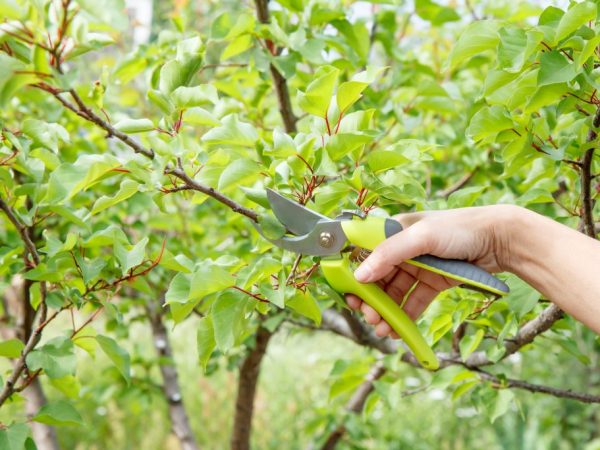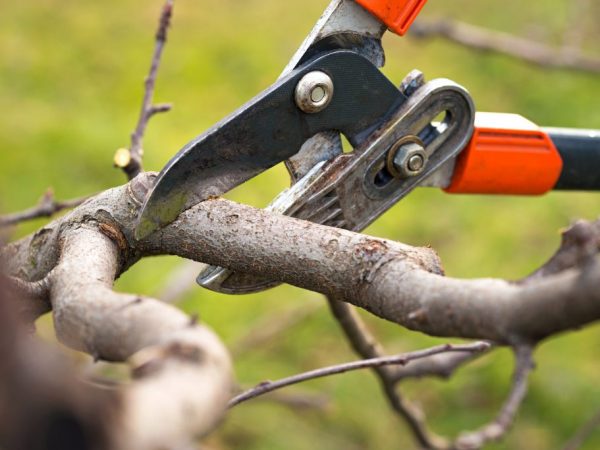Pruning apricots in the fall - step by step instructions
The apricot tree is characterized by intensive growth of shoots, which negatively affects the state of the culture and fruiting, so pruning is necessary in the fall. Otherwise, the active growth of branches will lead to the appearance of various pathologies.

Pruning apricots in the fall - step by step instructions
Objectives of the procedure
It is necessary to prune apricots for:
- Formation of a neat crown, the plant gaining an attractive appearance. Protruding, overly elongated processes are subject to removal.
- Rejuvenation. Due to the active formation of fruits and thickening of the crown, the culture ages quickly, the branches located inside dry out, the fruits become small, and are formed in small quantities.
- Prevention of deformation of branches, their breaking off under the weight of the fruit.
- Resumption of development of shoots with the same intensity in the spring.
- Improvements in sanitary conditions. Dry, frozen in winter, injured, disease-affected branches are subject to removal.
Pruning is a way of giving an aesthetic appearance to the crown, ensuring abundant and high-quality fruit formation, as well as extending the life of the culture.
Optimal timing
Pruning after the arrival of cold weather and regular rainfall makes the culture weak. For the sections to tighten quickly, the temperature must be above 8 ° C.
The optimal time is from early to mid-October.
- In the southern regions, the dates have been shifted to later dates: at the end of October - beginning of November.
- In the north, it is carried out much earlier, in September.
The procedure is extremely important for a seedling up to 5 years old. Without it, the correct crown will not form. For adult plants, it is held every 2 seasons.
Pruning methods
Shoots are cut off from early and mid-season varieties. The scheme is determined by the purpose of forming the crown.
- Regulatory - to maintain a balance between plant development and the number of fruits. Carried out when the crop is harvested.
- Shaping - to give a neat and attractive shape to the crown, stimulate the growth of branches and the formation of ovaries in spring. Young seedlings are sheared.
- Rejuvenating to accelerate the development of new and growth of old shoots on mature trees.
- Sanitary - for removing sick, shriveled, injured branches.
- Restorative to rejuvenate shoots, stimulate the formation of ovaries.
The autumn procedure implies an ennobling, rejuvenating, regulating effect.
Required tools
To form a crown, take:
- secateurs;
- saw;
- grafting knife;
- bar for sharpening blades;
- twine for a garter;
- material for covering the sections.
First of all, the tools need to be disinfected and sharpened well. The knife is sharpened against a wet bar to remove iron shavings. The pruner is disassembled before sharpening, after which the blade is checked for sharpness.
If necessary, adjust the degree of nut tension: either make it tighter or release it.
Before starting the procedure, the saw teeth are tilted alternately in different directions - left and right, trying to make the same tilt angles.
Step-by-step instruction
Shaping haircut

The tool must be sharp
This type of pruning is important for a young tree so that the feeding of the fruiting branches in the new season is uniform.
A discharged longline method is used - 6 or 7 strong shoots are left, located about 40 cm from each other.
- In the first season, the trunk is cut by ¼. A young seedling remains with 2 main shoots, the gap between them is about 30 cm.Other branches are shortened so that they are less than the trunk by 20 cm.
- In the second year, two fresh shoots are cut off, leaving about 40 cm between them.
- After that, similar manipulations are carried out, lengthening the gap by 10 cm.
The branches of the main shoot are shortened by half if they are longer than 60 cm. The short ones are kept intact.
Frail branches, potentially incapable of fruiting, are pinched until they are strong.
To provide lighting for each part of the tree, the branches are cut off, directed towards the center of the crown.
Anti-aging pruning
Allows to restore the development of shoots, is carried out for old trees annually for several seasons.
Scheme:
- The plant is carefully examined. Non-fruiting branches are identified and cut at an angle of 45 °.
- Then several strong healthy shoots are selected and all or only the largest branches are removed from them.
Follow-up care
The primary task is to lubricate the sections with a protective pitch. Processing is carried out immediately after the procedure, until the tree sap begins to flow abundantly.
You can buy the tool in a store or make it yourself. There are two popular recipes.
- Cold-resistant var. Take fir resin, ethyl alcohol, beeswax in a ratio of 10: 1: 1. The wax and resin are placed in a metal container, heated with constant stirring to a liquid state. Warm alcohol is poured into the slightly cooled mass, stirred. The consistency of the finished substance is such that it is easy to spread with a brush. The resulting protective crust is waterproof, plastic, and does not deform during temperature fluctuations.
- Warm-melting var. Take 400 g of rosin, 200 g of wax, 250 g of flax oil, 100 g of unsalted fat. Rosin, wax, fat are placed in a metal container, heated, but not allowed to boil. Pour in oil. The mass is thoroughly stirred until it acquires a viscous consistency. The solution hardens as the temperature drops, so it has to be heated in a steam bath.
You can also take oil paint, drying oil. It is strictly forbidden to use artificial coloring materials and immature manure: the sections will be covered with poorly healing burns.
On large cuts, the protective coating may crack before the surface is tightened. In such a situation, the var is re-spread.
It is important to carefully monitor the condition of the slices, to prevent infection of the shoots and the outflow of juice.
After that, standard agrotechnical measures are carried out:
- watering;
- treatment for infection and insects;
- mulching.
Mistakes that gardeners make
- The use of blunt instruments, leading to damage and flaking of the bark, which increases the likelihood of infection of the wood;
- Violation of the timing of the event lowers the immunity of plants and delays the recovery period;
- Removing the main branches not along the "ring", but close to the trunk, which is why hollows appear;
- The location of the first tier is too high, as a result of which, in an adult tree, fruits will form at a height of 2 m from the earth's surface, and it will be problematic to remove them.
What happens if you do not trim
When carried out in a timely manner, pruning provides abundant and high-quality fruiting. If you do not form a crown, then the young apricot will grow quickly, but soon the gardener will notice the negative consequences:
- the central shoot will be too elongated, it will become frail;
- thinned branches will break off under the weight of ripening fruits;
- the fruits become smaller.
It is not difficult to form a crown. The main thing is to adhere to the established schemes, properly prepare the tools, follow the rules for caring for the fruit crop. And then the tree will remain healthy, strong, annually will delight with a rich and sweet harvest.

